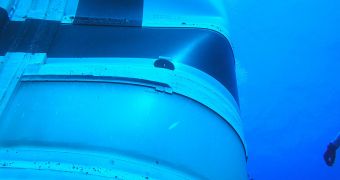A little more than one month ago, NASA finally managed to launch its newest rocket prototype, the ARES I-X. The delivery system is to be the backbone of Project Constellation, the space agency's new approach to space exploration, which is scheduled to start running in 2015-2016. Everything went smoothly with the initial flight, even though some delays were necessary on account of the weather. But something also clouded the success of the mission, the unexpected failure to deploy a parachute.
The failure puzzled experts at NASA, who are still investigating the root cause of this event. Thus far, they have been unable to come up with a satisfactory explanation of why one of the chutes failed to deploy, and thus caused a large dent in the first stage of the prototype. Recovery teams scouting the Atlantic Ocean for what remained of ARES I-X's active first stage found that it had been damaged by the landing, much more than experts anticipated. The splashdown occurred with only one of three parachutes deployed, which meant that the stage impacted the water at very high velocities.
“We're still investigating what happened there and why,” the Ares I-X System Engineering and Integration Office Chief, Marshall Smith, said on Thursday. One possible explanation may be the fact that the parachutes started opening up earlier than planned. This would have resulted in them taking on more air pressure than they were designed to. Being exposed to large forces, they would fail regardless of the materials they were made out of, experts at the space agency say, quoted by Space. At first, scientists feared that the two stages might have hit each other again after separation, but a detailed analysis of the evidence proved that this was not the case.
“It didn't really matter. We did asses this possible failure scenario before launch,” Ares I-X Mission Manager Bob Ess explains. ARES I-X's flight was meant primarily to assess the viability of the primary engines. Of the five segments that made up the first stage, only four were live, and equipped with instruments that would actually go on ARES I. The second stage, featuring a mock-up of the Orion Crew Exploration Vehicle, was entirely dummy, but designed in a way that replicated the actual weight distribution that would be seen on the real rocket.

 14 DAY TRIAL //
14 DAY TRIAL //